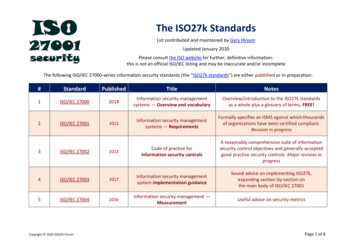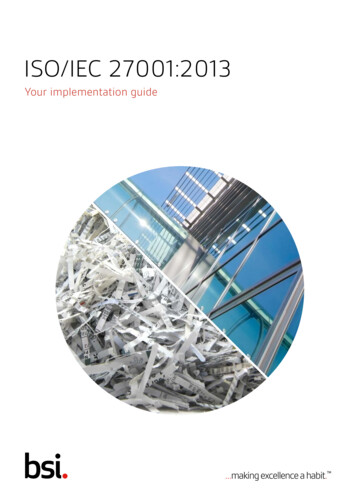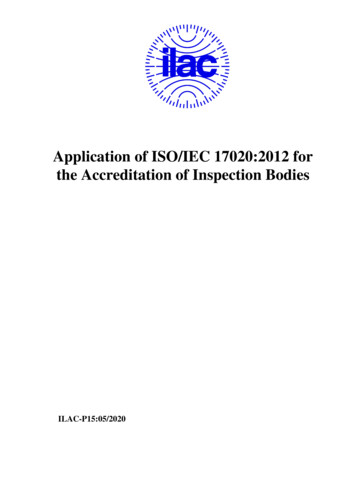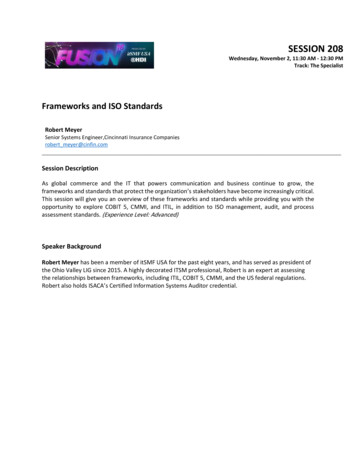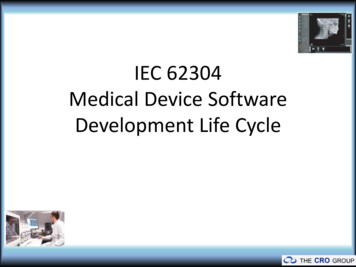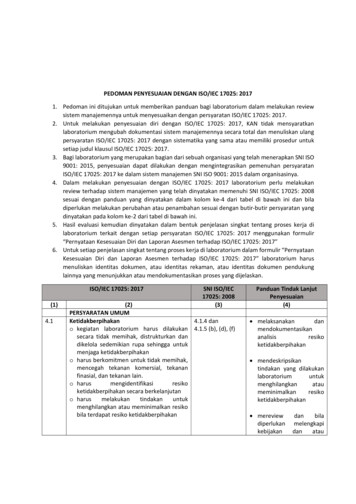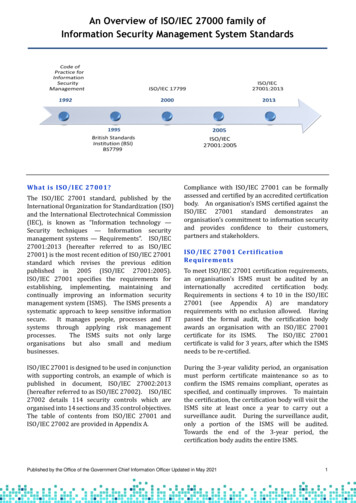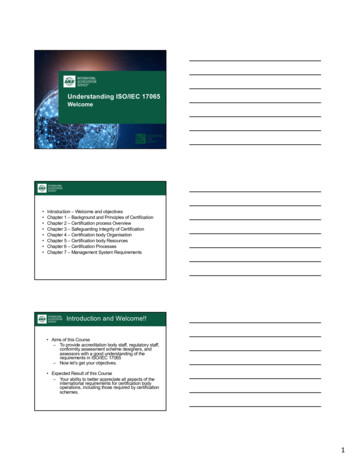
Transcription
Understanding ISO/IEC 17065WelcomeCourse Syllabus Introduction – Welcome and objectivesChapter 1 – Background and Principles of CertificationChapter 2 – Certification process OverviewChapter 3 – Safeguarding Integrity of CertificationChapter 4 – Certification body OrganisationChapter 5 – Certification body ResourcesChapter 6 – Certification ProcessesChapter 7 – Management System RequirementsIntroduction and Welcome!! Aims of this Course– To provide accreditation body staff, regulatory staff,conformity assessment scheme designers, andassessors with a good understanding of therequirements in ISO/IEC 17065– Now let’s get your objectives. Expected Result of this Course– Your ability to better appreciate all aspects of theinternational requirements for certification bodyoperations, including those required by certificationschemes.1
ObjectivesOur Contract (We work for you)n We owe you: Deference Respect Honesty Some knowledge of the Subject Mattern We want from you ?Written Materials The following materials are available to assistparticipants in this course. Lets examine the binders. Course Notes Binder– Tab 1 – Course Handbook– Tab 2 – Presentations (these slides)– Tab 3 – Reference Materials» Generic ISO/IEC 17065 checklist– Tab 4 – Samples for Class Use– Tab 5 – Facilitator evaluation form and Quiz2
Written Materials, (cont’d) All participants are requested to checkmark each ISO/IEC 17065 clauseexamined during the course of these twodays. After lunch on day 2, we will see whathas not been touched to ensure all partsof the standard are covered.Applicant for CertificationBefore proceeding, it is important to recognise that theproduct, process or service to be evaluated and certified isthe “object for certification.” The organisation and peoplewho submit it for such evaluation is the client is forcertification. We will refer to them as the “Applicant” andthat term includes the following. applicant for certification; manufacturer using the process, or supplying the productthat is the object of certification, and supplier of the product, process or service that is theobject of certification.Your Grade and My Grade Participants who wish to receive a Certificate ofSuccessful Completion must participate in thediscussion activities in each chapter and obtain70% on the end-of-course quiz. We will score them collectively. You are all asked to evaluate the facilitator andthis course. What happens to the evaluation?See the feedback on www.motiva-training.com.3
Understanding ISO/IEC 17065Chapter 1 – Background/PrinciplesRationale for Certification Public trust directly from stakeholders. Regulatory requirement (also aimed at public trust). SafetyStandards vs Regulations4
Accreditation BodiesAccreditation serviceISO/IEC 17011Conformity assessment bodiesCertification InspectionBodyBodyISO/IEC 17021, 17065TestLab17020CalLab17025/1518917043, 17034Conformity Assessment iceRequirementsPurchasersRegulatorsISO 9000, 13485, 22000, 14000, 45000, 31000SuppliersTradeOrganizations& AuthoritiesDemands forcompetentconformityassessmentDemands forfacilitatingtradeConsensus to Establish TrustCBs ensure that all interested parties are part of thesolution (from Annex A to 17065):– the clients of the certification bodies;– the customers of the organizations whose productsare certified;– governmental authorities;– non-governmental organizations; and– consumers and other members of the public.Principles to Establish TrustAnnex A list and clauses affected in 17065 Impartiality - 4.2, 4.4, 5.2, 7.6 Competence – 6.1, 6.2, 7.1.3, 7.4.2 Confidentiality and openness– Confidentiality - 4.5– Openness - 4.4– Access to information – 4.6, 5.2.2, 7.8 Responsiveness to complaints and appeal – 7.13 Responsibility - 4.1, 5.1, 6.1.2, 6.2.2.4, 7.4.5, 7.6, 7.7.2,8.1, 8.2.3, 8.2.55
Certification Schemes Certification schemes are defined in ISO/IEC 17067. Certification schemes contain the requirements for thecertification of products, processes and services. Scheme owners can be:– certification bodies;– governments and regulators;– non-government organisations;– industry and retail associations; and– consumer organisations.Certification SchemesScheme owners can establish requirements for:– pre-requisites for certification bodies;– pre-requisites for the certification of conformant products,processes and services;– scheme owner participation in the processes leading to either ofthe above;– surveillance of products, processes and services for continuedcertification;– sanctions to all other parties for failure to conform to theirrequirements, and– supporting requirements such as cost recovery, legal liability, andconflict resolution.Certification Scheme TypesScheme types can be (from ISO/IEC Guide 67 & 17067): Type 1a (Certification of specific samples only) Type 1b (Certification by lot number, such as aircraft type certification)Type 2 (Certification through continuing after-market testing) Type 3 (Certification through continuing production line testing)Type 4 (Certification through continuing comprehensive re-testing) Type 5 (Certification through continued audit of the manufacturer andproducts)Type 6 (Certification of processes and services) Review the list on page 10 of the Course Handbook6
Certification Scheme TypesMinimum Certification Scheme Requirements: Determination of characteristics (evaluation)–testing,–inspection,–design appraisal,–assessment of services Technical Review (independent of evaluation) Decision on certification Surveillance (as required depending on scheme)Hierarchy of the Standards17065Knowledge of the science and use ofprofessional judgment to determineconformance – some is subjective.17020Knowledge of the science and use ofprofessional judgment to determineconformance – primarily objective.17025Knowledge of the science – objectivetest and calibration results.Commonality of StandardsAll developed based on the ISO/PAS series ofstandards (now incorporated into ISO/CASCORules): ISO/PAS 17001 Impartiality; ISO/PAS 17002 Confidentiality; ISO/PAS 17003 Complaints and appeals; ISO/PAS 17004 Disclosure of information, and ISO/PAS 17005 Use of management systems inconformity assessment.7
Commonality of StandardsCommon elements in all standards Organisation requirements;Management system requirements, responsibilities, confidentiality,impartiality, personnel and training, etc;Document control and control of recordsFeedback, including complaints;Disputes and appeals (where applicable);Handling of non-conformances through to corrective action (asappropriate);Handling of potential non-conformances and opportunities forimprovement through to preventive action (as appropriate);Internal audit, andManagement reviewCommonality of StandardsCommon look and feel Informative Preliminary Sections (Intro etc)Normative General SectionsNormative Technical SectionsInformative Supplementary Sections8
International ApplicationFive levels of IAF Recognition Level 1 - ISO/IEC 17011, specifies the criteria for theAccreditation Body (AB). Level 2 - Accreditation Activities, in which the AB hasdemonstrated competence to perform accreditation asspecified by the IAF endorsed generic accreditationnormative documents listed in Level 3. IAF MLAaccreditation activities are:– Management system certification– Product certification– Certification of personsFive levels of IAF Recognition Level 3 - IAF endorsed generic accreditation normativedocument used by the AB to assess the ConformityAssessment Body (CAB) competence for eachaccreditation activity. For example:– For management system certification - ISO/IEC17021– For product certification - ISO/IEC 17065– For certification of persons - ISO/IEC 170249
Five levels of IAF Recognition Level 4 – IAF endorsed sector specific normative documents which specifyinternationally recognized applications of the generic normative documentlisted in Level 3. The documents are used by the AB, in combination with thegeneric normative document listed in Level 3 to assess the CAB competencein the relevant sector. For example:– Normative document to be used in combination with ISO/IEC 17021: For certification of food safety management systems (FSMS) –ISO/TS 22003; For certification of information security management systems (ISMS)- ISO/IEC 27006.– Normative documents to be used in combination with ISO/IEC 17065: None currently endorsed– Normative documents to be used in combination with ISO/IEC 17024: None currently endorsedFive levels of IAF Recognition Level 5 – IAF endorsed conformity assessment normative document used byCABs. For example:– Normative document used by Management System Certification Bodies For certification of Quality Management Systems (QMS) - ISO 9001); For certification of Environmental Management Systems (EMS) – ISO14001; For certification of Food Safety Management Systems (FSMS) - ISO22000; For certification of Information Security Management Systems (ISMS)- ISO/IEC 27001.– Normative document used by Product Certification Bodies None currently endorsedFive levels of IAF Recognition10
ISO 9000, 13485, 22000, 14000, 45000, 31000 ISO/IEC 17021, 17065 17020 17025/15189 17043, 17034 ISO/IEC 17011 CBs ensure that all interested parties are part of the solution (from Annex A to


